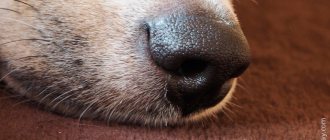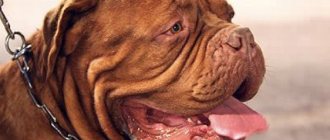You can indirectly monitor your dog’s health, in particular, by the consistency and color of feces. Changes in color and density indicate a disease of the stomach, liver, gall bladder or poor diet. Let's look at the causes of white stool, which is not always a symptom of the disease.
The normal results of a dog’s life are colored brown. White feces in a dog is not a normal phenomenon, the explanation for which needs to be found in a short time. Normally, feces are stained with bile, which plays an important role in a dog’s digestion. Bile is a very caustic substance, it helps to dissolve food in the small intestine, and unnecessary residues are eliminated from the dog's body naturally.
Causes of color loss
Every person, even those who do not have a pet, probably knows what the normal color of dog feces should be. If the animal is healthy, then its feces are dark or moderately light brown. This color comes from bile, a vital fluid produced by the liver. By the way, scientifically, white feces are called acholic.
When the liver or gallbladder is not in order, the dog may suffer from loss of appetite (especially the dog is literally sick of fatty foods), intestinal problems (sometimes diarrhea, frequent constipation), nausea and vomiting, flatulence, belching, spasmodic pain in the peritoneum, lethargy , sometimes temperature. It is because of problems with the production of bile that, as a rule, the dog’s feces are white, but the urine may be darker than usual. Also, with such illnesses, the skin, mucous membranes, and sclera of the eyes turn yellow.
When something is wrong with the animal’s organs, the feces begin to lighten, and the urine takes on a rich dark hue.
External signs of stool lightening:
- loss of appetite;
- manifestation of problems with the gastrointestinal tract (diarrhea, constipation, bloating);
- nausea and vomiting, regurgitation;
- yellowing of the mucous membranes and sclera of the eyes.
The dog may show anxiety; when the first symptoms and changes in the dog’s behavior appear, observe the dog and its habits. If they change without reason, conduct a visual inspection of the animal.
What should a dog owner do if colorless feces are detected?
The owner does not need to do anything special. Enough:
- analyze the dog’s nutrition over the last two days;
- make adjustments and correct feeding errors;
- Observe the next day or two for changes in the color of stool after normalizing nutrition;
- If within 1-2 days the excrement has not darkened, then this is a reason to seek advice from a veterinarian and have your pet examined.
If white feces are immediately accompanied by general malaise, loss of appetite, lethargy, diarrhea, or any fluctuations in body temperature (above or below normal), you should contact a specialist as soon as possible without waiting or observing!
"Shades" of white feces
Any change in color, the presence of inclusions, the appearance of mucus and plaque is a deviation in the functioning of the dog’s body.
The following types are distinguished according to structure and color:
- Feces covered with a white coating, or crumbly white feces - an excess in the nutrition of the bones, the possible appearance of parasites.
- Liquid white-gray or yellowish stool - improper diet, disruption of the gastrointestinal tract.
- White mucus is a disease of the large intestine or the presence of worms, an excess of connective tissue in the body (after a large consumption of stringy meat).
- Sometimes the owner can see white specks in brown stool. These could be pieces of undigested food or worms, if prevention has not been done for a long time.
Often the process of the appearance of feces is accompanied by the sounds of gases escaping from the rectum.
Blood in dog stool - causes
Blood in a dog's feces should be considered a dangerous pathology. This is a reason for a detailed examination. It is important to identify the cause and establish the location of the source where the blood is coming from. We are talking about the gastrointestinal tract or nearby areas. Blood impurity means that the bleeding is localized in the gastrointestinal tract.
If the blood has been affected by enzymes, it will be scarlet. It will also remain the same if the bleeding is localized in the distal region - the rectum, the area of the large intestine. It will be more difficult to detect it if the enzymes still “caught up”. In this case, it will look like coffee grounds. This is a situation where the active focus is in the esophagus and stomach.
Harmless causes of light-colored stool
Very often, the reason can be harmless and will not require the owner and the dog to visit a veterinary clinic.
Causes that can be eliminated without treatment:
- Eating foods high in fat for animals - lard, fatty meat, dairy products, cheese, pork. Animal fat is poorly digestible and leads to light-colored stool.
- Constant nutrition of bones. Hard and spicy foods negatively affect the functioning of the gastrointestinal tract and liver. If bones are constantly present in your dog's food, the stool will be hard and white. After changing the diet within 3 days, the stool returns to its normal consistency and color.
- Long-term treatment with drugs that affect the liver. To treat stomach diseases or diarrhea, animals are prescribed Smecta, Augmentin and other drugs. After completing the course of treatment, it is enough to add lactobacilli to the food, which will help the liver restore its protective functions.
- Dehydration – in addition to loss of color, feces become dry.
Treatment of stool with blood
The treatment course and health-improving measures depend on the identified cause that caused the abnormal stool. The veterinarian's main recommendations are:
Helminthic infestation is completely eliminated with the help of drugs such as:
- Drontal;
- Dironet;
- Kanikquantel (weighing more than 1.5 kg).
Dironet tablets for dogs
Puppies are treated with a suspension - Drontal Junior. Give once, repeat after 14 days. Medicines for worms are available in the form of tablets, drops, and solution. The first ones are given, hidden in the sausage before breakfast. The solution is injected into the mouth. If the worms are dead in the body, it is necessary to give the animal a laxative. Anti-parasite therapy often results in diarrhea, lethargy and poor appetite.
Hemorrhagic gastroenteritis is treated by a specialist; self-medication is unacceptable. To restore electrolyte balance, infusion therapy is prescribed. If your pet has no appetite, you should not force feed it. Antibiotics are prescribed to eliminate infection in the intestines. To stop vomiting - antiemetics. In severe situations, plasma is used.
Enteritis . If enteritis occurs in a puppy, it is important to follow a diet and start therapy in a timely manner. It is better to feed your dog rice porridge with milk. Treat with penicillin and vitamins. They also give immunostimulants that enhance internal strength. Vitamin therapy helps normalize the general condition.
Symptoms of parvovirus enteritis in dogs
Treatment of enteritis in dogs
Plague . Accompanied by an inflammatory process in the stomach and pancreas. Therapy includes analgesics, fever medications and antibiotics. To normalize stool, astringents are prescribed.
Video - Distemper in dogs
Haemorrhoids. Hemorrhoids are treated in animals in the same way as in humans. The drugs are similar. This is Relief or Procto-glivenol. Detralex is also given to the pet along with food. It is not forbidden to make a chamomile decoction for a sitz bath. The water temperature should be made 2 0 lower than the dog’s temperature. Sea buckthorn oil will also help if you lubricate the anus with it. You can also moisten a tampon and insert it into your pet’s anus; internal cracks will heal faster.
Poisoning by poison . If a dog accidentally/non-accidentally eats a dead rat or its “special” food, it is important to quickly induce vomiting in the dog. Also use laxatives and absorbents. It is recommended to get your bearings and empty your stomach as quickly as possible. The cleansing procedure should be repeated every 4 hours. If there are seizures, it is necessary to give the animal an anticonvulsant drug.
Video - First aid for dog poisoning
If you have a dog in the house, it is important to supervise him like you would a small child. Observe bowel movements and behavior. Only with a detailed study (without going deep) can life-threatening conditions for the puppy be identified in time.
You can indirectly monitor your dog’s health, in particular, by the consistency and color of feces. Changes in color and density indicate a disease of the stomach, liver, gall bladder or poor diet. Let's look at the causes of white stool, which is not always a symptom of the disease.
Diseases that cause white feces
The scientific name for white feces is acholic, translated from Greek as “without liver,” since it is the liver that is responsible for coloring feces. The main causes are liver and gall bladder diseases, the manifestation of early symptoms of which the owner did not pay attention to.
The problem of white feces is caused by:
- Gallstones are sand or stones in the gallbladder and/or its ducts. With their sharp and uneven edges, the stones injure the mucous membrane of the gallbladder, sometimes they close the ducts and cholestasis (stagnation of bile) begins.
- Malignant neoplasms - the presence of a tumor of an oncological nature causes disruption in the functioning of the entire body, and first of all, the outflow of bile stops.
- Cholecystitis (Cholangitis) is inflammation of the gallbladder and ducts. The dog is vomiting with a large amount of mucus. Vomit contains bile, which irritates the gastric mucosa and leads to flatulence, diarrhea and bloating. The animal becomes lethargic, moves apathetically, and fever often sets in. Due to pain inside the abdominal cavity, she often lies on her stomach, arching her back.
- Liver cirrhosis is an intensive and irreversible replacement of healthy cells by fibrous tissue.
- Hepatitis is an inflammation of liver tissue. Appears along with diseases of the stomach and pancreas. In the body, protein, carbohydrate-fat and pigment metabolism is disrupted, and organ cells disintegrate. The dog's temperature rises.
- Cholangiohepatitis is inflammation of the liver and ducts at the same time.
- Cysts are the appearance of operable benign formations that impede the normal functioning of the organ.
- Deformation of the bile ducts is a change in the normal shape or size of the gallbladder, adhesions. The disease is congenital or acquired.
- Pancreatitis is inflammation of the pancreas.
And on the Internet they say...
On the Internet you can find a huge number of various communities and forums, on the pages of which people write about how they cope with various diseases of their pets. There is, of course, information about white feces.
Many owners write that often a problem of this kind (the appearance of white and gray-white feces) appears when the dog eats bones. Whether the owners themselves give food of this kind to their pet, or the animal finds it somewhere on the street, the result in the form of white excrement is the same.
Forum members write that waste in the form of bones can turn a dog’s liver into a garbage dump. They recommend owners a budget-friendly way to feed their dog: cereal porridge with the addition of skin, meat trimmings, offal, and absolutely no bare bones should be given to the pet.
Love and care can also help the animal avoid many health-related problems; you should not be negligent about your dog’s health.
Feces are one of the most important indicators of the health of our pets. It is its sudden changes that can become the first alarming signal that prompts the owner to show his pet to a veterinarian before a serious deterioration in the animal’s well-being. Normally, a dog's bowel movements should be brown in color and have a hard consistency. Any deviations from this “standard” indicate an imbalance in the pet’s body - temporary or chronic. Green feces in a dog is one of the variants of a deviation that can put the owner into a stupor. We will talk about the causes of green bowel movements below.
Stool turns green due to the action of copious amounts of bile enzymes such as bilirubin or biliverdin. As a rule, when it comes to green feces, we mean a liquid consistency, since the solid form of bowel movements usually does not imply such a shade. Loose stool itself should alert the pet owner, especially if it is repeated and does not stop for several days.
Owner behavior - prompt assistance
If you see white feces on your dog for the first time, there is no need to panic. Analyze all the reasons for its appearance and observe the animal for 2-3 days. If your dog's stool does not change and his behavior becomes alarming, consult a doctor.
Before prescribing treatment, the veterinarian will ask the animal to conduct the following tests:
- urine and blood to identify inflammatory processes and the condition of the liver; in difficult cases, instead of a general study, a biochemical study will be performed;
- stool and biochemical urine analysis to determine the condition of the pancreas;
- if neoplasms are suspected, ultrasound of the abdominal cavity;
- X-ray of the liver or in some cases a biopsy.
Based on research results, doctors prescribe treatment in several areas:
- Antibiotic therapy (Trichopol, Cephalexin).
- Choleretic (Allohol, Holosas).
- Hepatoprotectors (Hepatoject, Hepatovet).
- Antispasmodics and analgesics (No-Shpa, Baralgin, Butofanol).
- Enzymes (Mezim, Creon).
If the presence of a cyst or cancerous tumor in an animal’s body is confirmed, surgery is always performed.
Proper dog nutrition
Regardless of the reason why the animal has white feces, its diet needs to be changed.
It is prohibited to give your pet:
- homemade cheese, sour cream and cottage cheese;
- fat and lard;
- bones;
- strong broths;
- pasta;
- raw vegetables and fruits;
- smoked sausages, wieners and frankfurters.
If an animal eats dry food, you should not buy cheap food that does not contain the necessary microelements to improve the functioning of internal organs. You cannot buy cheap canned food for animals that contains a lot of low-quality by-products.
It is important to include in your diet the systematic use of:
- Boiled lean meat - beef or turkey, skinless chicken.
- Cereals (oatmeal, buckwheat, pearl barley).
- Boiled vegetables (carrots, zucchini, cauliflower).
- Low-fat cottage cheese and kefir.
- Fish or beef broth.
Feed 5-6 times a day, in small portions, until complete recovery. After surgery, especially if cancer has been diagnosed, you need to undergo a preventive examination and tests once every 6 months.
Sources:
https://www.belanta.vet/vet-blog/pochemu-u-sobaki-beliy-kal/
https://dogcatfan.com/476-pochemu-u-sobaki-belyj-kal.html
https://vashipitomcy.ru/publ/sobaki/bolezni/belyj_kal_u_sobaki_prichiny_diagnostika_vozmozhnykh_zabolevanij/26-1-0-2111











